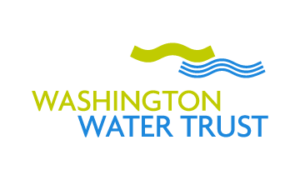Collaboration Key to Keeping the Dungeness River Flowing During the 2019 Drought
“Well, of course we participate in the leasing program – there’s no snowpack and we need to keep water in the river,” declared Mary Bell over the phone to Washington Water Trust Project Manager Emily Dick.
The river in need of water that Mary was referring to is the Dungeness River, located in the rain shadow of the Olympic Mountains on the northeast corner of Washington’s Olympic Peninsula. The leasing program she mentioned is the Dungeness Dry Year Leasing Program which Mary and her husband Delane participated in both this year and in 2016.
Dry year leasing is a drought response effort utilized when rivers and streams are expected to drop to very low levels in the summer. Willing farmers agree not to irrigate some of their acreage for the last month of irrigation season (August 15 – September 15) and are paid per acre for their reduced water use. That water, normally drawn directly from the Dungeness River, remains in the river instead where it helps to restore habitat, prevent low flows from impeding safe upstream passage of salmon and steelhead as well as reduce water temperatures that can prove fatal to the fish.

In 2019, the period of January through August was the fourth driest in the Dungeness since 1895. The Dungeness and many of Washington’s rivers and streams depend on the snowpack in the mountains. Typically, as the snow melts throughout the spring and summer, water is released into the rivers and streams providing them with cool water until the rains return in the fall. This water, in turn, sustains Washington’s farms, communities, businesses, wildlife, and fish including Endangered Species Act listed salmon, steelhead and bull trout. However, below average snowfall and early snowpack melt, as occurred this year, can spell trouble with less water available in late summer – a crucial time when both crops and returning fish need water the most.
This year’s dry conditions prompted Governor Jay Inslee to declare a drought emergency in 27 watersheds across Washington including the Dungeness River basin where Washington Water Trust has been working for more than a decade and manages a local water bank. An official declaration of drought activates emergency funding for Washington’s Department of Ecology. These funds can then be used to support drought response efforts like dry year leasing to help Washington weather the storm, or rather, lack thereof until the fall.
This year, Dungeness drought response funding was made significantly more robust thanks to a significant investment from a new local partner: Alaska Airlines. Alaska Airlines – who was connected to the work of the Washington Water Trust and the Dungeness Dry Year Leasing Program through the Bonneville Environmental Foundation’s Water Restoration Program – understood the risks to fish, farms and communities posed by the drought emergency and saw the Dungeness Program as a great opportunity to support a local community while simultaneously promoting water stewardship.

Due to Washington Water Trust’s experience and relationships in the Dungeness basin, Bonneville Environmental Foundation and the Department of Ecology turned to us to reach out to farmers in the area about leasing their irrigation water through the Dungeness Dry Year Leasing Program. In addition to Mary and Delane Bell, nineteen other farmers signed on to participate, resulting in water typically used to irrigate 1,350 acres being kept in the Dungeness River instead. This water increased the flow in the river by as much as 12% during this critical period when flows were well below the state’s minimum flow targets. Washington state’s Drought Coordinator Jeff Marti emphasized the importance of restoring flow in the Dungeness, “The Dungeness River is a small river which is asked to do a lot. In drought years, flows can get so low that the river is no longer passable. Imagine a salmon – 8 inches tall from its belly to the tip of its dorsal fin – trying to swim upright through 2 inches of water. They need our help. That’s why the work that Washington Water Trust performs, working with landowners to voluntarily reduce their irrigation, is so valuable. It makes a small river just a little bit bigger and benefits our salmon runs.”

For Mary and Delane Bell, who have been farming in the Dungeness basin since the 1960s, their decision to participate in the program was a combination of economic incentive and their love for the river. Mary explained how it allowed them to continue to make a living while not having to work their fields for the last month of irrigation season. “Irrigating is hard work. This dry year lease came at a good time, Delane is getting older and he needed a break from irrigating.” Having observed changes firsthand in the Dungeness basin for more than 50 years, Mary and Delane predict that drought response programs like the Dungeness Dry Year Leasing Program will need to be used more frequently in the future. “It’s getting hotter, the water is gonna go away and the wells will be empty,” Delane states. Mary follows: “I know the glaciers are melting in Alaska, so there’s no telling if our snowpack is gonna stay.”
